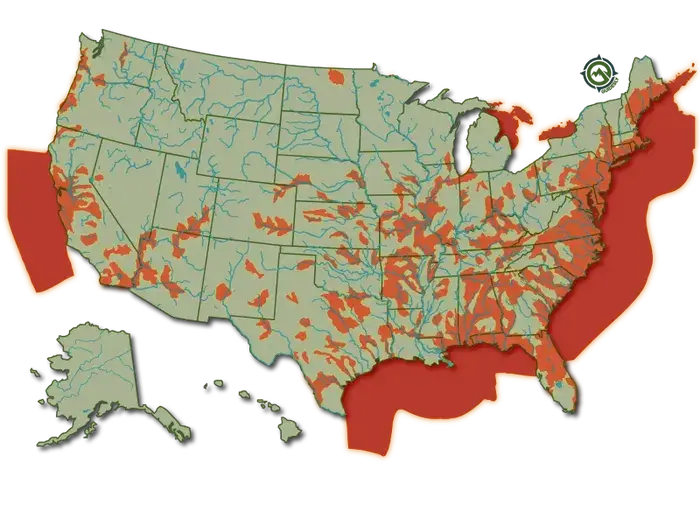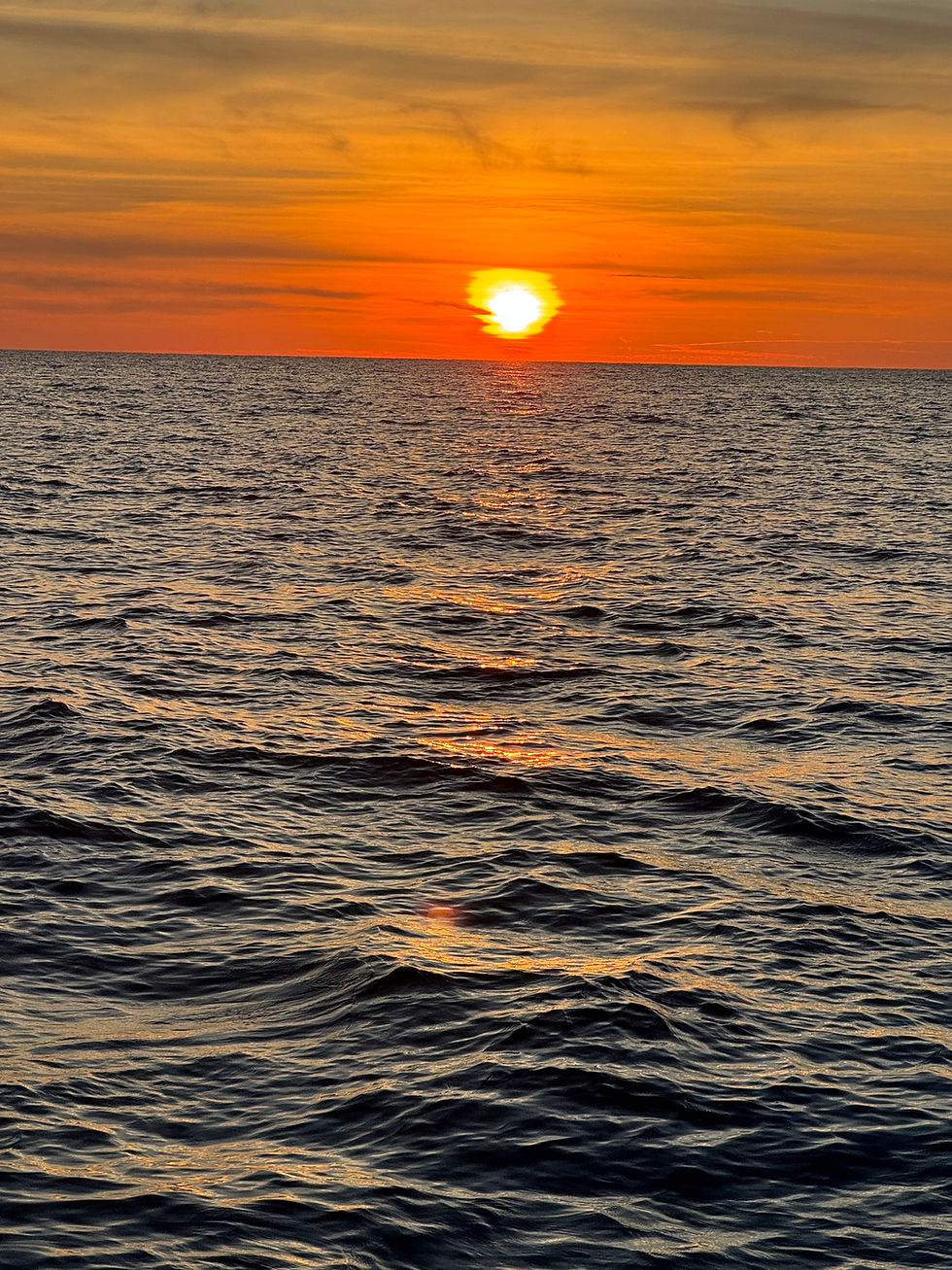The Striped Bass Migration
- Pedro DeCosta
- Dec 21, 2024
- 4 min read
Updated: Oct 6
The Atlantic Striped bass, or “stripers,” are a highly migratory species found along the entire Atlantic Coast, ranging from Florida all the way to Canada. Although Canadian waters host their own populations of striped bass, Atlantic stripers also migrate that far north. Many people don’t realize just how extensively these fish travel. As the seasons change, they cover great distances. In spring, they head north into warmer waters rich in baitfish, taking advantage of these conditions to spawn. In autumn, as temperatures drop, they return south in search of calmer, cooler waters that provide shelter during the winter months.

Striped bass are considered anadromous fish because, during their spawning migration, they move from saltwater— their preferred environment—into freshwater to breed. Spawning occurs in the Savannah River, Georgia, near the end of March, while it takes place in mid-June in the Miramichi River of New Brunswick. The highest concentrations of spawning striped bass occur in the Albemarle Sound and its tributaries, including the Roanoke River in North Carolina, as well as in the Delaware River, the Chesapeake Bay and its tributaries, and the Hudson River in New York.
Reasons for Migration
Striped bass are always on the move, primarily to find abundant sources of food and suitable spawning grounds. In spring, warmer temperatures draw them north, where baitfish are plentiful. This ensures they have the energy needed for successful spawning. In the fall, cooler temperatures and reduced competition for food lead them back south, allowing them to conserve energy and maintain stable populations.
Seasonal Timing and Routes
Each year, striped bass follow a predictable pattern: traveling north in spring, then south in fall. As water temperatures rise in spring, they enter rivers and freshwater areas to spawn. Afterward, they move into coastal waters and rivers to feed. In fall, when temperatures begin to drop, they reverse course, heading south to overwinter.

Travel Distances
Striped bass are endurance swimmers capable of traveling up to 3,000 miles. This journey—one of the longest for any North American freshwater fish—can be more than twice the distance covered by other migratory species like salmon or shad.
Where and When to Find Them
Striped bass can be caught year-round if you understand their habits. They adjust their depth, feeding times, and locations based on water temperature, available sunlight, and the season. In early spring, look for them in shallower waters warmed by the sun. As summer progresses, striped bass often hold in deeper, cooler waters. In fall, with dropping temperatures, they can be found in transitional areas near structure. In winter, venturing deeper or hiring a local guide can greatly improve your chances.
Striper Feeding Patterns and Water Temperature
Striped bass feeding habits and temperature preferences don’t follow a simple formula. Although warmer water generally holds less oxygen than cooler, deeper areas, this doesn’t always translate into straightforward feeding behavior. Interestingly, during the coldest winter months, when surface temperatures dip, stripers are often more inclined to feed near the top.
In terms of depth, a sweet spot for catching stripers is generally between 15 and 20 feet below the surface. At this level, they have convenient access to baitfish closer to the top and cooler, more oxygen-rich water below.
Contrary to what some anglers believe, stripers don’t necessarily slow down their feeding in winter. They remain active and hungry, meaning they can still be successfully targeted even in the coldest part of the year. While many anglers dream of hooking a striper smashing a surface bait, these fish can surprise you. Sometimes, they’ll feed on lobsters or other bottom-dwelling creatures, especially when they retreat to greater depths to avoid intense sunlight and heat.

Does Water Temperature Affect Striper Spawning?
This has been a big, often-debated topic in recent years along the East Coast. The Chesapeake Bay, one of the largest producers of juvenile striped bass, has seen many back-to-back years of low recruitment, according to available data. I am no scientist, but I believe some of this data might be flawed. First, I think their patterns have changed due to climate change. The general consensus isn’t that the striper population is low, but that the fish are not spawning as much as expected. It’s possible these fish have begun spawning in different locations, which is plausible considering how much they migrate.
Second, I suspect environmental issues may be at play. Something could be affecting water quality in the Chesapeake Bay, but exactly what is unclear. More resources should be invested to determine what is happening. This is a sensitive topic for many, so I won’t delve too deeply, but I hope we can figure it out and avoid placing a moratorium on this wonderful fishery.
Lastly, striper spawning generally kicks off in April and can stretch into June, though it’s not unusual to encounter spawners later due to shifting climate patterns. If surveys are conducted only during specific times, we might be missing late-spawning events. During the spawning season, the fish head inland to reproduce, exhibiting unusual behaviors—such as chasing one another—and changing the way anglers must approach them.
Spawning season often makes stripers more eager to feed and more vulnerable to various fishing tactics. Capitalizing on this can lead to highly productive outings, particularly for those using small plastics and jerk baits in shallow coastal inlets and lagoons. With careful planning, you can intercept these fish as they move into bays and inlets. Anglers fishing from boats can even employ trolling techniques.
Conclusion
In the end, understanding striped bass migration means respecting their rhythms, habitats, and the challenges they face. These remarkable fish undertake incredible journeys each year, traveling from the deep South to the cold, clear waters of Canada and adapting to changing conditions along the way. For anglers, it’s not just about catching fish—it’s about appreciating a resource that is both resilient and vulnerable.
As we learn more about these migrations, their spawning behavior, and the intricate relationships among water quality, climate, and sustainable fisheries management, we gain the perspective needed to protect this species for generations to come. The ongoing conversation about striped bass will undoubtedly shape how we fish, how we conserve, and how we ensure these storied creatures continue their grand coastal voyages well into the future.




Comments